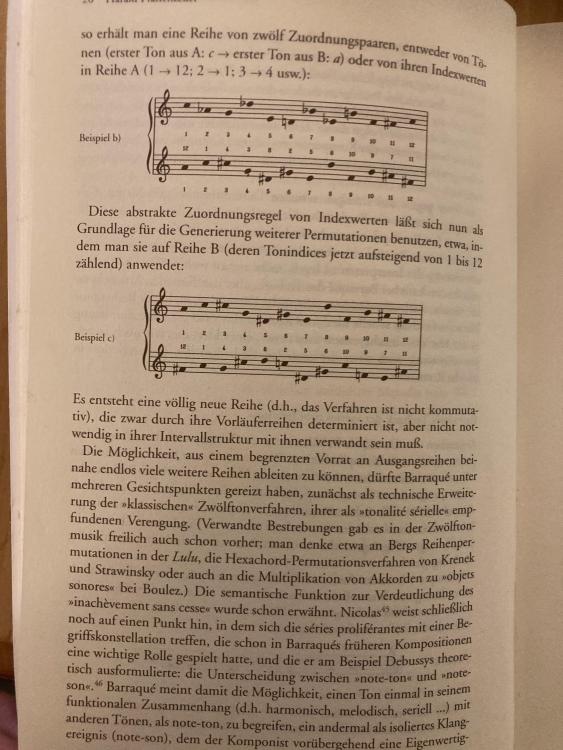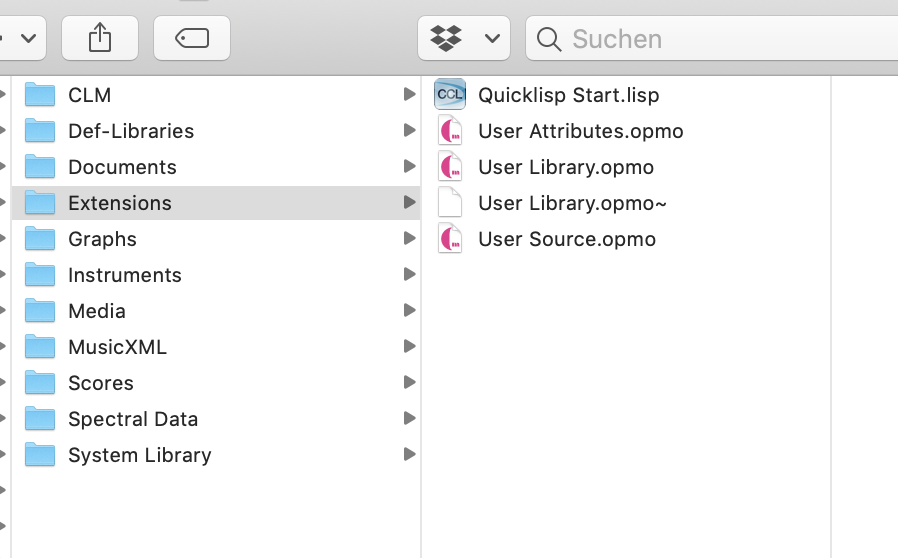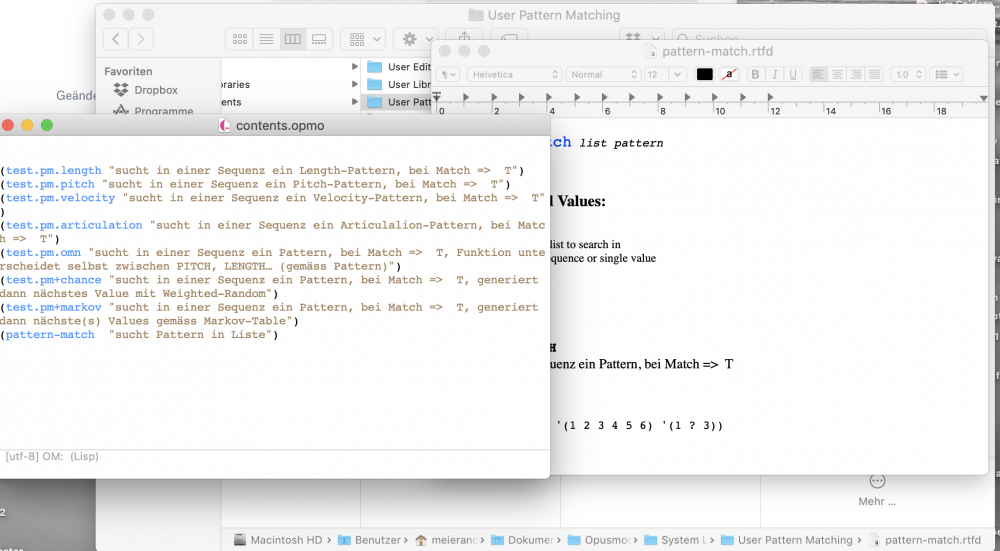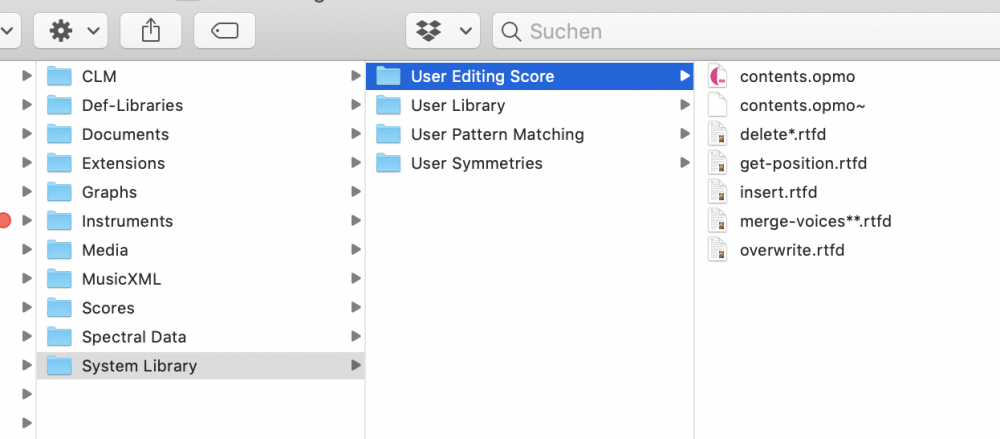-
Posts
793 -
Joined
-
Last visited
Content Type
Forums
Events
Store
Video Gallery
Everything posted by AM
-
Das Wachstumprinzip von L-Systemen in der Musik von Hanspeter Kyburz - PDF Kostenfreier Download DOCPLAYER.ORG Hochschule für Musik Hanns Eisler Abteilung D Charlottenstr Berlin Masterarbeit Das Wachstumprinzip von L-Systemen in der Musik von Hanspeter Kyburz Eres Holz 30. April 2012 Inhaltsverzeichnis
-
here a function... to barraqué's techniques (defun serie-proliferantes (row) (let* ((ri_row (pitch-invert (gen-retrograde row))) (row (loop for z in (loop for x in (pitch-to-midi ri_row) collect (or (position x (pitch-to-midi row)) (position (- x 12) (pitch-to-midi row)) (position (+ x 12) (pitch-to-midi row)))) collect (nth z ri_row)))) row)) (serie-proliferantes '(c5 ab4 g4 db5 e4 d4 bb4 eb4 b4 f4 fs4 a4)) => (fs4 a4 g4 cs5 d5 c5 eb5 gs4 b4 f4 e5 bb4) Jean Barraqué — Wikipédia FR.WIKIPEDIA.ORG seen here: https://www.amazon.de/Jean-Barraqué-Musik-Konzepte-Heinz-Klaus-Metzger/dp/3883774499 page 19-20
-
perhaps some (old) hocket-function... ?
-
for my current project i have to CONVERT/MAP pitches/lengths/velocity or MIDI into a binary sequence. so i coded this simple FUNCTION... feel free to use/adapt.... greetings andré (defun fill-to-x-bit (listseq &key (bitlength 7)) (loop for i in listseq when (< (length i) bitlength) collect (append (gen-repeat (- bitlength (length i)) 0) i) else collect i)) ;;;; CONVERT PITCH/LENGTH or VELOCITY TO BINARY INFORMATION (defun convert-to-binary (alist &key (parameter 'pitch) (length-resolution 127) (velocity-resolution 127) (pitch-resolution 127) (event nil) (bitlength 7)) (let ((pitch) (length) (velocity) (alist (progn (setf alist (cond ((stringp alist) (flatten (midi-to-omn alist :instrument 1))) (t alist))) (if (omn-formp alist) (cond ((equal parameter 'pitch) (setf alist (omn :pitch alist))) ((equal parameter 'length) (setf alist (omn :length alist))) ((equal parameter 'velocity) (setf alist (omn :velocity alist))) ((equal event 't) (setf alist (single-events alist)))) alist)))) (if (null event) (cond ((pitchp (car alist)) (progn (setf alist (pitch-to-midi (pitch-melodize alist))) (fill-to-x-bit (decimal-to-binary (vector-round 0 (if (null pitch-resolution) (- (find-max alist) (find-min alist)) pitch-resolution) alist)) :bitlength bitlength))) ((lengthp (car alist)) (fill-to-x-bit (decimal-to-binary (vector-round 1 length-resolution (mapcar 'float (omn :length alist)))) :bitlength bitlength)) ((velocityp (car alist)) (fill-to-x-bit (decimal-to-binary (vector-round 1 velocity-resolution (get-velocity alist))) :bitlength bitlength))) (progn (setf pitch (progn (setf alist (pitch-to-midi (pitch-melodize (omn :pitch alist)))) (fill-to-x-bit (decimal-to-binary (vector-round 0 (if (null pitch-resolution) (- (find-max alist) (find-min alist)) pitch-resolution) alist)) :bitlength bitlength))) (setf length (fill-to-x-bit (decimal-to-binary (vector-round 1 length-resolution (mapcar 'float (omn :length alist)))) :bitlength bitlength)) (setf velocity (fill-to-x-bit (decimal-to-binary (vector-round 1 velocity-resolution (get-velocity (omn :velocity alist)))) :bitlength bitlength)))))) ;;;;;;;;;;;;;;;;;;;;;;;;;;;;;;;;;;;;;;;;;;;;;;;;;;;;;;;;;;;;;;;;;;;;;;;;;;;;;;;;;;;;;;;;;;;;;;;;;;;;;;;;;;;;;;;;;;;;;;;;;;;;;;;;;;;;;;;;;;;;;;;;;;;;;;;;;;;;;;;;;;;; ;;;;;;;;;;;;;;;;;;;;;;;;;;;;;;;;;;;;;;;;;;;;;;;;;;;;;;;;;;;;;;;;;;;;;;;;;;;;;;;;;;;;;;;;;;;;;;;;;;;;;;;;;;;;;;;;;;;;;;;;;;;;;;;;;;;;;;;;;;;;;;;;;;;;;;;;;;;;;;;;;;;; ;;;;;;;;;;;;;;;;;;;;;;;;;;;;;;;;;;;;;;;;;;;;;;;;;;;;;;;;;;;;;;;;;;;;;;;;;;;;;;;;;;;;;;;;;;;;;;;;;;;;;;;;;;;;;;;;;;;;;;;;;;;;;;;;;;;;;;;;;;;;;;;;;;;;;;;;;;;;;;;;;;;; (convert-to-binary '(c4 cs5 fs3 c5 f5) :bitlength 15) (convert-to-binary '(-e e -q h e) :bitlength 15) (convert-to-binary '(p p ffff mp ) :bitlength 15)
-
i'm very interested in!! thx to you JULIO!!! strukturnetz is not a piece, it's "a kind of technique" he used you could read about it here: https://www.amazon.de/Differenzen-Poststrukturalistische-Beispiel-Lachenmann-Ferneyhough/dp/3931264157 listen here... the STRUKTURNETZ is also "notated" in the score (on top)
-
like that? should work... it "loops" x-times (depends on length of seeds-list) and collect the rhythms... (setf seeds (vector-round 1 100 (gen-white-noise 8 :seed 13))) (setf rhythm (loop for i in seeds collect (euclidean-rhythm 16 4 16 's :type 2 :seed i))) perhaps there is an OPMO-solution, this is LISP
-
would be interesting. it has quite some (distant?) aspects of LACHENMANN's "strukturnetz", and could be nice to work in such an direction...
-
dear ole i have no "preseted" soundsets for my work... in my current "sketch" i'm using/something something like this.. ;;;;;;;;;;;;;;;;;;;;;;;;;;;;;;;;;;;;;;;;;;;;;;;;;;;;;; ;;;;;;;;;;;;;;;;;;;;;;;;;;;;;;;;;;;;;;;;;;;;;;;;;;;;;; (add-text-attributes '(e-bow "e-bow") '(harm-I "harm-1") '(harm-II "harm-II") '(harm-III "harm-III") '(harm-IV "harm-IV") '(harm-V "harm-V") '(harm-VI "harm-VI")) (def-sound-set gm-guitar :programs (:group guitar ord 0 bartok-pizz 1 tap 2 ponte 3 harm-I 4 harm-II 5 harm-III 6 harm-IV 7 harm-V 8 harm-VI 9)) (def-sound-set gm-vibraphone :programs (:group vibraphone ord 0 tap 2)) (def-sound-set gm-piano :programs (:group piano ord 0 e-bow 1)) for this CT-setup... git vibra pno.cePlayerOrc
-
or... (loop for x from 7 downto 1 for y from 1 to 7 collect (list x 3 y))
-
i have been working with conTimbre for a long time and it is exactly what i was looking for. playing techniques can easily be done by OPMO or SIBELIUS (vst3) via program changes. it has a great many different playing techniques. I always found IRCAM_LIB to be very inadequate, as there were not enough playing techniques etc. / you can also control CT via OSC (and as standalone or via MAXMSP). when I wrote for ensemble with additional e-player, CT-live always worked very well. (The only negative point I could say is that there are a few SAMPLES that weren't played / recorded very well. But with the size of the library, that's okay with me)
-
Dear all Today I dealt briefly how to control PROCESSING (software and programming language) by Midi. There is a great interface for this: "rwmidi" by Giuseppe Torre. You can download and install it, it works fine! A short Video (no Sound) with a very simple Processing Example movie.mov I think this is a good combination if you want to visualize your midi output (or just use de midi-data in realtime) or if you want to program a separate VISUAL track in OPMO. Here is a small example (I can't program usable in PROCESSING yet, sorry :-)) Downloads etc. are here ... https://processing.org https://gitlab.com/giuseppetorre/rwmidi-revival-master here's a video, how to install etc... https://www.youtube.com/watch?v=7iFUenT5B68&feature=youtu.be and as an attachm. my "sketch" in processing sketch_Processing_from_Midi.pde Greetings André P.S. I think there ist also a way to send data by OSC
-

generating realtime score / sending data from OPMO to POLYTEMPO NETWORK by OSC
AM replied to AM's topic in Function Examples
thanks... i will post the CODE and some videos etc. when i have finished the work - premiere will be in november... greetings andré -
dear all here's an example (from my current work)... this little video shows how i generate/display SCORE (instrumental parts) on a screen + virtual conductor (piano part). the example is "nonsense", but shows how it looks/works... you see the bars (generating), the cue, beat... and the arrow (that shows you where to read/play) ...also you hear some bad (sry) sound-simulation of the setup. in this way i can generate a whole piece in realtime on STAGE (all musicians will read their part from their own screen). this one will be for 5 instruments, ePlayer and modular synthesizer. during the performance an algorithm (or some data-streams) will generate the piece in OPMO. with OSC i can send all datas (score, beat, tempo..) from OPMO to POLYTEMPO-NETWORK (https://polytempo.zhdk.ch) and work and coordinate different independent tempo layers, conducting etc... for more POLYTEMPO informations... have a look here: https://polytempo.zhdk.ch greetings andré IMG_0083.MOV
-
here is a sketch for an alternative "binary-(or element-)layer-FUNCTION (defun element-layer (lists &key (rnd nil)) (let ((lists (if (null rnd) lists (rnd-order lists :list t)))) (car (last (loop for x in (rest lists) with list = (car lists) collect (setf list (loop for i in list with cnt = 0 when (equal i 0) collect (nth cnt x) and do (incf cnt) else collect i))))))) (element-layer (list '(1 0 0 1 1 0 0 1 0 0 0 0) '(0 2 3 0 4 5 0 6 0 7 8 0) '(11 12 13 14 15 16 17)) :rnd nil) => (1 11 2 1 1 3 12 1 4 5 13 6) ;;; hierarchic: every 0's will be replaced by the values from the next/sub-list...
-
testing videoplayer in OPMO.mov whitenoise.mov
-
- testing
- videoplayer
-
(and 2 more)
Tagged with:
-
you want to map some integers (in your case pc..) to attributes? like that? (position-filter '(0 1 2 3 4 5) '(pizz arco ponte molto-ponte stacc stacc+pizz ten+arco ten+molto-ponte)) => (pizz arco ponte molto-ponte stacc stacc+pizz) (position-filter (pcs '6-Z10) '(pizz arco ponte molto-ponte stacc stacc+pizz ten+arco ten+molto-ponte)) => (pizz arco molto-ponte stacc stacc+pizz ten+molto-ponte) or in pure CCL (loop for i in '(0 1 2 3 4 5) with attr-list = '(pizz arco ponte molto-ponte stacc stacc+pizz ten+arco ten+molto-ponte) collect (nth i attr-list)) => (pizz arco ponte molto-ponte stacc stacc+pizz)
-

Patrick Mimran. Extension folder , user function question
AM replied to PatrickMimran's topic in Support & Troubleshooting
i've made different user folders... named: user editing user pattern matching .... ...or you could put all in the same... (i realized for my work, that most of the time i'm using a "coded function" only for a specific project/work. so i stopped it to put all special functions into my user library. now, i have the functions only in my project workspace...) -

Patrick Mimran. Extension folder , user function question
AM replied to PatrickMimran's topic in Support & Troubleshooting
-
in german... https://www.amazon.de/Programmieren-COMMON-LISP-Otto-Mayer/dp/3860257102 (but without LOOP) https://www.tutorialspoint.com/lisp/index.htm https://lisptips.com https://www.youtube.com/channel/UCMV8p6Lb-bd6UZtTc_QD4zA
-
you're welcome!! i think for specific solutions it helps a lot to learn some LISP-basics (loops/conditionals/car/cons/...), then you have the possibility to make your own additional functions/libraries in OPMO. and OPMO is really great for such things!! greetings andré
-
like that..?... some code... greetings andré (defun replace-velocities-in-a-seq (omn-list &key pitch velocity-list) (flatten (loop with cnt = 0 for i in (single-events omn-list) when (equal (cadr i) pitch) collect (omn-replace :velocity (nth cnt velocity-list) i) and do (incf cnt) else collect i when (> cnt (length velocity-list)) do (setf cnt 0)))) (replace-velocities-in-a-seq '(e c4 ppppp d4 d4 e4 f4 d4 d4 g4 b4 d4 d4 d4 d4) :pitch 'd4 :velocity-list '(p mp mf f ff)) ;=> (e c4 ppppp e d4 p e d4 mp e e4 ppppp e f4 ppppp e d4 mf e d4 f e g4 ppppp e b4 ppppp e d4 ff e d4 ppppp e d4 p e d4 mp) ;; if there are more 'd4's then velocity-values, -> it starts again with first velocity-value (= cycle)
-
okay, then it seems to be a AUDULUS- or MOD-SYNTH-"problem". (audulus is only for simulation, real mod-synth for live) thanks!
-
dear janusz at the moment i'm working with AUDULUS 3 and OPMO, work's fine. but there are some problems with the articulation. is it possible that in ord. there is a little "overlapping" between two notes? in this case AUDULUS don't "recognize" a change of velocity etc... with stacc it works fine (but with a gap). is there a "non-overlapping"-articulation with almost no gap between the notes? thanks andré
-

reduce note lengths in a list programmatically?
AM replied to etu's topic in Support & Troubleshooting
(setf scale '(c4 d4 e4 f4 g4 a4)) (setf scale (omn-replace :length 'e scale)) ;; or (make-omn :pitch '(c4 d4 e4 f4 g4 a4) :length '(e q e e s t)) -

reduce note lengths in a list programmatically?
AM replied to etu's topic in Support & Troubleshooting
you could use LENGTH-MODIFY "LENGTH-MODIFY will modify a series of lengths by adding, subtracting, multiplying or dividing them with a list of duration values. If the count argument is not given to LENGTH-MODIFY then the count is chosen at random."







